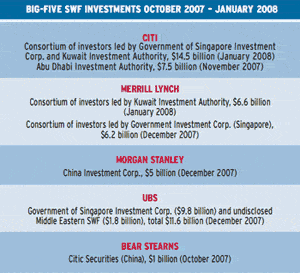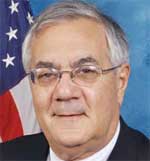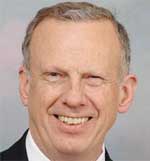Sovereign wealth funds snap up bargains in one of the biggest financial industry land grabs in history.
 |
|
|
To say Citi and Merrill Lynch—two Wall Street powerhouses better known for their blue-ribbon credentials and financial smarts than for bleeding red ink—have hit a rough patch would be an understatement.
Earlier this year Citi, the biggest US bank, reported a fourth-quarter loss of $9.8 billion after taking a $22.2 billion write-down against the subprime mortgage crisis. A couple of days later Merrill Lynch—the country’s biggest brokerage firm—also posted a $9.8 billion, fourth-quarter loss, which it blamed on a $16.7 billion write-down, primarily for non-performing mortgages and related financial instruments such as collateralized debt obligations (CDOs). It was the worst quarterly result in the history of both Wall Street banks, who weeks earlier signaled they were working to clean up their mess by appointing new CEOs: Vikram Pandit at Citi and John Thain at Merrill.
Citi and Merrill are far from alone in getting knocked on their heels by a subprime mortgage meltdown that has thrown global equity markets into a tailspin and threatens to plunge the US economy into the worst recession in decades. They are joined by other top banks, including UBS, Morgan Stanley, HSBC, Bear Stearns and Barclays. In fact, combined write-downs by financial services companies with exposure to bad subprime loans totaled $140 billion by the end of January 2008, according to CIBC World Markets. US banks racked up three quarters of that sum.
 |
|
US treasury secretary Henry Paulson. |
However, what’s even more surprising than the magnitude of losses and write-downs is the lightening speed at which humbled Wall Street bankers were able to reverse the tide of misfortune. As quickly as their balance sheets began to crumble, America’s biggest banks secured multi-billion-dollar capital injections from some of the world’s biggest sovereign wealth funds (SWFs)—pools of capital controlled by cash-rich governments that have ushered in a new era of global capitalism with their sortie into the beating heart of Lower Manhattan.
“I can’t think of a parallel for such massive concentrations of ownership by state entities,” says Peyton Young, a senior fellow at the Brookings Institution and James Meade professor of economics at Oxford University. “Sovereign wealth funds are not just economic actors; it’s absurd to claim this.”
Congressman Barney Frank, a Democrat from Massachusetts, says, “There’s a concern that investments are being made for other than investment purposes.” Frank, who chairs the powerful House Financial Services Committee, adds that politicians in the United States are considering imposing rules on SWFs, including investment caps and limits on board membership.
Safety Net or Spider’s Web?
Opinions are mixed about SWFs—some of the biggest of which are controlled by undemocratic governments with questionable ethical standards. Supporters say they are not much different from other kinds of institutional investors. “They put a floor under financial stocks,” says senior economist Peter Buchanan with CIBC World Markets in Toronto, referring to their bailout of US banks. For others they are motivated as much by political as by economic agendas, paving the way for a new era of economic colonialism.
 |
For example, it may not be a big deal if Norway’s Government Pension Fund, one of the word’s biggest SWFs, worth an estimated $322 billion, invests in global banking. But when the Chinese government does the same, it raises eyebrows because suddenly the same state that supports a dictatorship in Myanmar and annexation of Taiwan also has influence over Morgan Stanley and Bear Stearns.
Are SWFs wolves in sheep’s clothing with plans to take control of strategic global assets, beginning with banking and finance, in the name of the Arab world and China? “They make a lot of people in Washington very uncomfortable,” says Jim Lewis, a senior fellow at the Center for Strategic and International Studies (CSIS) in Washington. For example, a theory making rounds on the capital’s cocktail circuit these days is that China plans to buy up Wall Street and then pull the plug. This kind of doomsday scenario might make for an interesting Hollywood thriller, but it is unlikely to ever happen. “They like money as much as anyone,” says Lewis, referring to China’s government-controlled funds, relative newcomers to global investing. “They won’t blow themselves up.”
 |
|
Barney Frank: There is concern that investments are being made for other than investment purposes. |
That’s a view shared by Treasury secretary Henry Paulson, who considers the SWF rescue of Wall Street as a positive. “Some may be concerned that much of this financing came from overseas investors. I am not,” Paulson told a gathering of the New York Society of Securities Analysts earlier this year. “When the world invests in the United States, it is the ultimate vote of long-term confidence in our economy and our companies.”
The same day Citi reported fourth-quarter results in January, it also announced a $14.5 billion lifeline from the sale of convertible preferred securities to a consortium of investors led by the Government of Singapore Investment Corp. and Kuwait Investment Authority (KIA). This most recent top-up followed on the heels of a $7.5 billion capital infusion from the Abu Dhabi Investment Authority (the word’s biggest SWF, worth $875 billion) in November, when subprime mortgages first began eroding its balance sheet. Similarly Merrill Lynch, whose trademark bull has been emasculated by recent losses, was forced to raise $6.6 billion from a consortium led by the KIA the same week it announced year-end results. This followed a $6.2 billion capital upgrade in December from Singapore’s Government Investment Corp. (GIC) and a private investor. (GIC is the world’s second-biggest SWF, worth an estimated $330 billion. It is also parent of Government of Singapore Investment Corp.)
Three other global banking titans have in recent months turned to SWFs cap in hand to shore up capital positions: UBS raised $11.6 billion from the Government of Singapore Investment Corp. and an undisclosed Middle Eastern investor, Morgan Stanley $5 billion from China Investment Corp. (CIC), and Bear Stearns $1 billion from China’s government-controlled Citic Securities Co. (SWFs have also made significant investments in Barclays and HSBC, but these deals are unrelated to recapitalization due to bad loans.) “For people sitting on a lot of money, the subprime crisis was an opportunity to pick up assets that were expensive a year or two ago,” says Lewis with CSIS.
 |
|
Jim Lewis: China’s sovereign wealth funds like money as much as anyone else. They wont blow themselves up. |
But if US bank shares were such a bargain as a result of bad mortgages, why were private equity and pension funds not scrambling for an equal share of the action? “Turning to SWFs allowed banks to deal with their loan problems quicker,” says Carter McDowell, chief legislative council with the American Bankers Association (ABA), which represents the $12.7 trillion industry. Were it not for this state-controlled capital, banks would have been forced to negotiate deals with smaller institutional investors and to raise additional capital on public markets—a lengthy exercise that would have raised more questions about the industry’s health and further depressed valuations. “The scale of investments limited the field to a few players,” says Young of Brookings, noting Citi would have needed to negotiate with as many as 10 pension funds to secure the kind of capital it needed.
SWFs have been around for decades, but since the beginning of the new millennium their numbers have doubled to about 40. The old guard mainly represents Asian and Gulf interests, but newer arrivals include Russia, Chile and Venezuela. With a combined asset value of between $2.5 trillion and $2.9 trillion, SWFs are already bigger than either private equity funds or hedge funds and are expected to grow at a faster rate. As a result, analysts predict total assets controlled by SWFs could top $15 trillion by 2015. It is no wonder that these giant pools of capital sloshing around the world make some Western European leaders nervous, including France’s president Nicolas Sarkozy, who has vowed to defend domestic companies against influence by foreign states.
Cash To Burn
SWFs have hit their stride in recent years as a result of one of the biggest global economic booms in history. This boom has put enormous foreign exchange assets in the hands of commodity-rich countries such as Saudi Arabia, the United Arab Emirates and Russia, on the one hand, and industrial, export-driven economies, most notably China and Singapore, on the other. With so much money burning holes in the pockets of these prosperous economies, it was just a matter of time before SWFs started to flex their collective financial muscle.
 |
|
Peyton Young: There is no parallel for such massive concentrations of ownership by state entities. |
However, it is important to note that while the dollar value of investments made by state-controlled funds in the US banking industry are unprecedented, they all translate into individual stakes of less than 10%. “They’re all below anything that rises to the level of control,” says McDowell of the ABA.
On the plus side, a strategic investment by an SWF can open doors to new business opportunities. The latest buzz in US banking circles is that China Investment Corp.’s decision to invest $5 billion in Morgan Stanley could help the US bank win business in the tightly regulated Chinese banking industry. But Beijing also plans to learn about Wall Street’s best practices from the inside and then apply that know-how to its domestic banks, say industry watchers.
All eyes will be on SWFs as the credit crunch plays out this year. Deutsche Bank warns that US banks could face a further $40 billion to $50 billion in bad debt write-downs. If that materializes, then SWFs will likely be asked to step up to the plate again. “Any future bump-ups will come in waves,” says Buchanan of CIBC World Markets, noting the next round of bank earnings comes in April. Maybe at that point SWFs will be forced to tip their hands if they return for another slice of Wall Street.
Erik Heinrich


